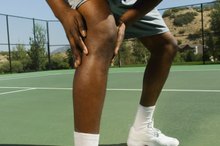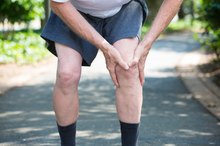Femoral Bone Contusions & Stretching
A femoral bone contusion is a deep bruise, or hematoma, of the thighbone. Contusions of the femur can occur from extreme blunt trauma to the thigh or from the femur jamming the tibia at the knee joint, which might happen if you landed awkwardly from a jump. Bone contusions cause deep, achy pain and often involve bruising and discoloration in the surrounding soft tissues. Icing, rest, light massage and cautious stretching encourage femoral bone contusions to heal, although many weeks or a few months of recuperation are typically needed. Consult with your doctor if you have an achy, swollen thigh.
Bone Contusions
A bone contusion typically refers to an injured bone that bleeds underneath its tough fibrous covering, called the periosteum. The injury causes small blood vessels to rupture, but the blood is contained within the periosteum where it usually is quickly reabsorbed without any complications or residual damage, according to the book “General and Systematic Pathology.” Bone contusions cause achy pain and inflammation and may involve bruising of the surrounding skin depending on the severity of the injury and if it was caused by external or internal force. In rare cases, bleeding from bone contusions can calcify and form protruding calluses of bone, which may compromise muscle movement.
The Femur
Running & Collarbone Pain
Learn More
Your femur is the bone of your upper thigh. It attaches your hip joint to your knee joint. Bone contusions of the femur occur more frequently than with other bones and are usually caused by impact during athletics, according to the book “Human Physiology: An Integrated Approach.” Football and soccer are especially risky sports for impact trauma to the thigh, whereas basketball and track and field events cause more jamming of the knee. The medial condyle of the distal femur is most susceptible to getting bruised when the femur and tibia become compressed or jammed.
Diagnosis and Treatment
A femoral bone contusion can mimic other injuries such as fractures, knee sprains, meniscus tears and muscle/tendon ruptures. A definitive diagnosis is made with an X-ray or MRI of the knee or femur. Treatment usually starts with application of ice several times per day for inflammation and pain control. Taking a break from physical activity and resting is also important. Ultrasound, microcurrent and light massage are other effective forms of treatment for bone contusions, as is stretching.
Stretching
What Are the Treatments for Thigh Splints?
Learn More
Resting your bone injury is a good idea, but complete inactivity is not recommended. According to “Exercise Physiology: Energy, Nutrition, and Human Performance,” performing nonweight-bearing, range-of-motion exercises to the knee and hip joints as well as lightly stretching the quadriceps muscles encourages blood flow, stimulates healing and prevents the joints and muscles from becoming stiff and tight. To do a quadriceps stretch, support yourself against a wall, grab your ankle and slowly bring your heel toward your buttocks. You should feel a pulling sensation in the front of your thigh. Go slow and be cautious, and stop immediately if the pain becomes much worse. Ask your physiotherapist about treating your bone bruise and stretching your quadriceps.
Related Articles
References
- General and Systematic Pathology; Paul Bass et al.
- Human Physiology: An Integrated Approach; Dee Silverthorn and William Ober
- Clinically Oriented Anatomy; Keith L. Moore
- Exercise Physiology: Energy, Nutrition, and Human Performance; William D. McArdle et al.
Writer Bio
Sirah Dubois is currently a PhD student in food science after having completed her master's degree in nutrition at the University of Alberta. She has worked in private practice as a dietitian in Edmonton, Canada and her nutrition-related articles have appeared in The Edmonton Journal newspaper.









